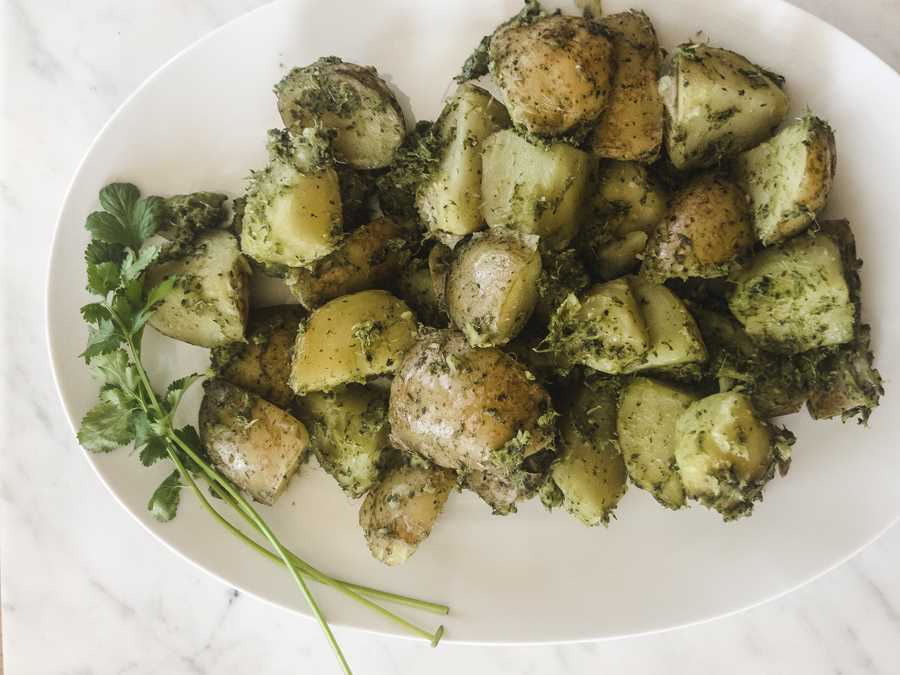Potatoes are a staple in many cuisines around the world, appreciated for their versatility and nutritional value. However, have you ever come across green potatoes while preparing a meal? If so, you may have wondered whether these green potatoes are safe to cook and consume.
The green color of potatoes is an indication that they have been exposed to light, particularly sunlight. When potatoes are exposed to light, they produce chlorophyll, a pigment responsible for the green color. While the presence of chlorophyll is not harmful, it is often accompanied by another compound called solanine.
Solanine is a natural toxin found in potatoes, especially in the green parts or sprouts. It acts as a natural defense mechanism for the plant, protecting it from pests and diseases. Consuming large amounts of solanine can cause various symptoms, such as nausea, vomiting, and even neurological effects.
Therefore, it is generally recommended to avoid cooking and eating green potatoes. In case you have accidentally purchased or obtained green potatoes, it is best to discard them to ensure your safety. If you have potatoes with minor green spots, you can trim off the green parts and cook the rest. However, it is important to be cautious and ensure there is no bitter taste or unusual odor, as these may indicate the presence of solanine.
Tip: To prevent potatoes from turning green, store them in a cool, dark place, away from sunlight. Additionally, minimize the exposure of potatoes to light during transportation and storage.
Is It Safe to Eat Green Potatoes?
Green potatoes are a common concern among consumers due to their potentially harmful effects. The green color in potatoes is caused by the presence of a chemical called solanine. Solanine is naturally produced by potatoes as a defense mechanism against pests and diseases.
Consuming green potatoes can lead to various health issues, as solanine is toxic to humans in large amounts. Symptoms of solanine poisoning include nausea, vomiting, stomach cramps, and diarrhea. In severe cases, it can cause difficulty in breathing, changes in heart rate, and even death.
Causes of Green Potatoes
Potatoes turn green when they are exposed to light. This is because light triggers the production of chlorophyll, which is responsible for the green color. The greening process occurs when potatoes are stored in areas with excessive lighting or when they are left exposed to light for extended periods.
Additionally, potatoes that are old or have been damaged during harvesting or storage are more likely to turn green. Bruises or cuts on the skin of the potato allow more light penetration, leading to increased greening.
How to Handle Green Potatoes
If you encounter green potatoes, it is best to avoid consuming them. Cutting off the green parts may remove some of the solanine, but it is difficult to determine how much remains in the potato. Therefore, it is safer to discard green potatoes.
To prevent potatoes from turning green, store them in a cool, dark place, away from direct light. Keep them in a well-ventilated container with a lid to protect them from exposure. It is also important to inspect potatoes before consuming and discard any that show signs of greening or damage.
In conclusion, eating green potatoes is not recommended due to the potential toxicity of solanine. It is best to store and handle potatoes properly to prevent them from turning green and becoming a health risk.
What Causes Potatoes to Turn Green?
Green potatoes can sometimes appear unappetizing, but have you ever wondered what causes them to turn green? Here are a few factors that contribute to the greening of potatoes:
1. Exposure to Light
When potatoes are exposed to light, they produce chlorophyll, the same pigment that gives plants their green color. This process is known as greening. The greening of potatoes is a natural defense mechanism that protects them from the harmful effects of light.
2. Storage Conditions

Potatoes should ideally be stored in a cool, dark place to prevent greening. When exposed to light and elevated temperatures, the greening process accelerates. Therefore, it is important to store potatoes in a cool environment, away from direct light.
3. Length of Storage
As the length of potato storage increases, the chances of greening also increase. Potatoes that are stored for a long period of time are more likely to turn green compared to freshly harvested ones. That’s why it’s important to consume potatoes within a reasonable time frame.
To prevent greening, it is recommended to store potatoes in a dark, cool place. If you notice green patches on your potatoes, it’s best to peel off the green skin and discard it. The green parts of the potato can contain solanine, a toxic compound that can cause mild gastrointestinal symptoms.
Now that you know what causes potatoes to turn green, you can take the necessary precautions to keep your potatoes fresh and free from greening.
Are Green Potatoes Poisonous?
One of the biggest concerns when it comes to green potatoes is their potential toxicity. The green color usually indicates the presence of a chemical called solanine, which is produced in response to exposure to light and high temperatures.
Solanine is a natural toxin found in many members of the nightshade family, including potatoes. In high concentrations, solanine can cause symptoms such as nausea, vomiting, stomach cramps, and even paralysis in severe cases.
However, it’s important to note that not all green potatoes are necessarily poisonous. The concentration of solanine can vary greatly depending on the potato variety, growing conditions, and storage conditions.
The best way to determine if a green potato is safe to eat is by assessing the extent of greening. If only a small part of the potato has turned green, you can simply cut off the green portion and discard it. The rest of the potato should be fine to consume.
If the greening is extensive or the potato has a bitter taste, it’s best to err on the side of caution and throw it away. This is particularly important for pregnant women, children, and individuals with compromised immune systems, who may be more susceptible to the potential adverse effects of solanine.
To minimize the risk of greening, it’s advisable to store potatoes in a cool, dark place away from direct sunlight. Also, avoid storing them near onions, as the gases released by onions can accelerate the greening process.
In conclusion, while green potatoes can potentially be toxic due to the presence of solanine, not all green potatoes are dangerous to eat. Careful assessment of the extent of greening can help determine if a green potato is safe for consumption.
The Dangers of Eating Green Potatoes
Green potatoes may seem tempting to cook, but they can pose serious health risks if consumed.
Why do potatoes turn green?
When potatoes are exposed to light, they produce a natural toxin called solanine. This toxin is a defense mechanism to protect the potato from pests and diseases. As a result, a green pigment called chlorophyll is formed, indicating that solanine levels have increased.
What are the dangers of eating green potatoes?
Solanine is toxic to humans and can cause a range of symptoms when ingested in large quantities. These symptoms include nausea, vomiting, diarrhea, stomach cramps, and even coma in extreme cases. Additionally, solanine can have a cumulative effect on the body, meaning that repeated consumption of green potatoes can lead to long-term health issues.
How to avoid the risks?
The best way to avoid the dangers of eating green potatoes is to prevent them from turning green in the first place. Store potatoes in a cool, dark place away from light. If you notice green spots on a potato, cut them out generously before cooking. Peeling the potato can also remove a significant amount of solanine.
Conclusion
While it may be tempting to cook green potatoes, it’s essential to be aware of the potential dangers they pose to your health. Taking precautions to prevent potatoes from turning green and removing any green spots can help ensure that you enjoy safe and healthy potato dishes.
How to Safely Cook Green Potatoes
Green potatoes contain a high level of a toxic substance called solanine, which can be harmful if consumed in large amounts. If you have green potatoes, it is important to take certain precautions while cooking to minimize the risk of solanine poisoning. Follow the steps below to safely cook green potatoes:
Step 1: Inspect and Remove Green Parts
Before cooking, carefully inspect all the potatoes for any green patches or discoloration. These green parts often contain the highest concentration of solanine. If you spot any green areas, use a knife or peeler to remove them completely. Ensure that there are no green portions left on the potatoes.
Step 2: Cut the Potatoes into Small Pieces
To ensure uniform cooking and reduced cooking time, cut the potatoes into small, evenly sized pieces. This will also help in removing any remaining green parts that may have been missed during the initial inspection.
Step 3: Blanch the Potatoes
Blanching the potatoes helps to further reduce the solanine content. Bring a pot of water to a rolling boil and add the cut potatoes. Boil them for about 5 minutes, then drain and rinse them with cold water. This process will help remove some of the solanine present on the surface of the potatoes.
Step 4: Cook Thoroughly

When cooking green potatoes, it is important to ensure they are cooked thoroughly. Solanine degrades at high temperatures, so boiling, baking, or frying the potatoes at a temperature of 170°C (340°F) or higher is recommended. Avoid eating green potatoes that have been lightly cooked or have a firm texture, as they may still contain a significant amount of solanine.
Note: While these steps help reduce the solanine content in green potatoes, it is always best to avoid consuming them altogether, especially if they have a strong bitter taste or an unpleasant odor.
Stay safe and enjoy cooking!
Questions and answers
Why are green potatoes not safe to eat?
Green potatoes contain a toxic compound called solanine. It is produced when potatoes are exposed to sunlight or stored in warm conditions for too long. Solanine can cause nausea, vomiting, and even neurological effects if consumed in large amounts.
How can you tell if a potato is green?
You can tell if a potato is green by its skin color. Green potatoes have a greenish hue to their skin, which is caused by the build-up of chlorophyll. Additionally, the flesh of green potatoes may also have a slightly green color.
Can you still cook green potatoes?
It is not recommended to cook and eat green potatoes. While cooking may reduce the solanine levels, it is difficult to completely eliminate the toxin. It is best to discard green potatoes to ensure your safety.
Are there any health risks associated with eating green potatoes?
Yes, there are health risks associated with eating green potatoes. The solanine in green potatoes can cause various symptoms such as nausea, vomiting, diarrhea, and stomach cramps. In severe cases, it can even lead to neurological symptoms like confusion, hallucinations, and paralysis.






